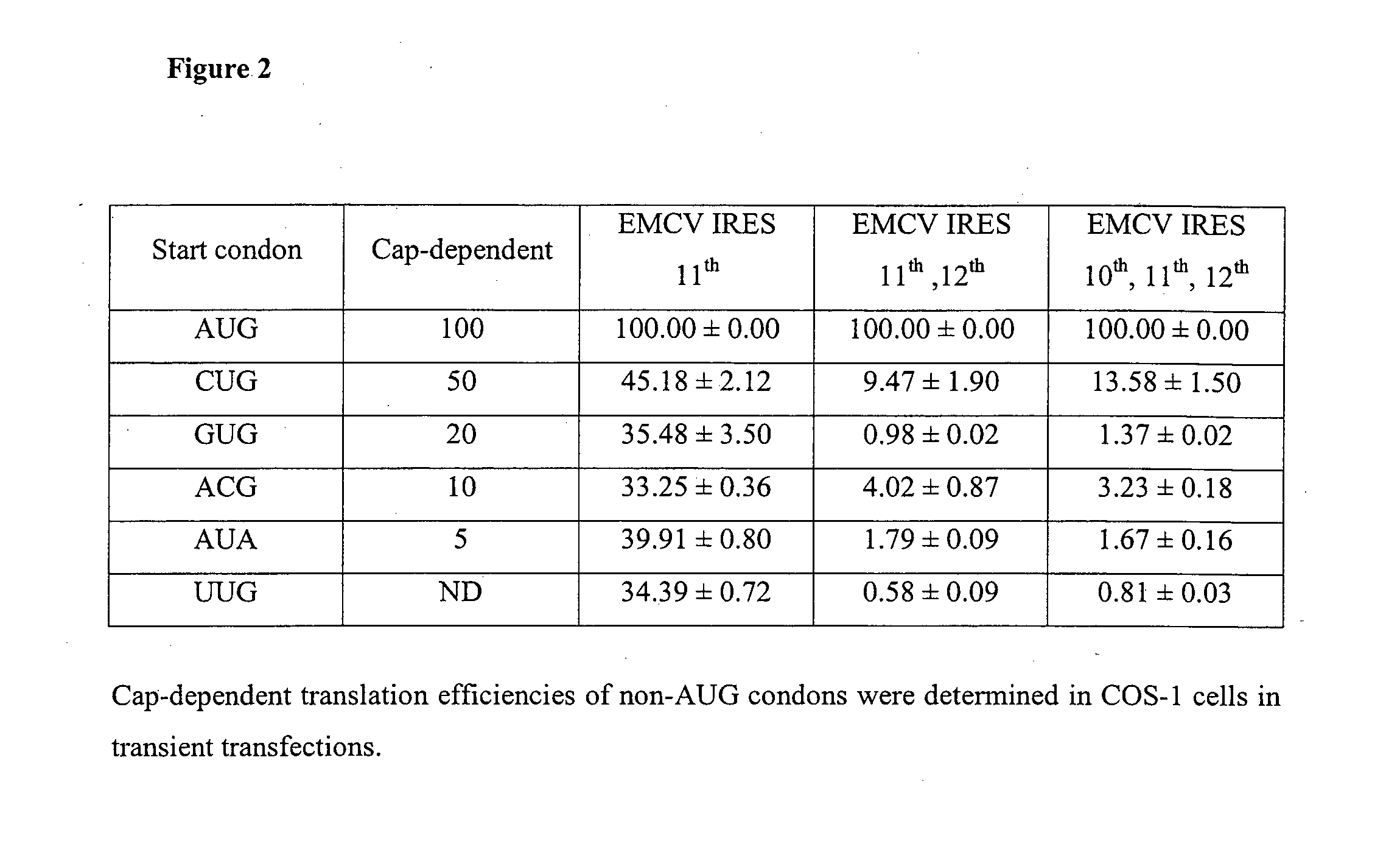Mutated internal ribosomal entry site (IRES) for controlled gene expression
a gene expression and entry site technology, applied in the field of molecular biology, can solve the problems of unfavorable control of gene expression, inability to modulate the expression ratio between the proteins of interest, and attachment of unwanted residues, so as to reduce the expression of protein and reduce the translation of the cap-dependent
- Summary
- Abstract
- Description
- Claims
- Application Information
AI Technical Summary
Benefits of technology
Problems solved by technology
Method used
Image
Examples
example 1
Expression Intensity of EMCV IRES Variants in CHO K1 Cells
[0134]25 EMCV IRES variants were generated by mutating ATG-10, ATG-11 or ATG-12 in the IRESwt (SEQ ID NO:1) individually or in combination to GTG, CTG, ACG, ATA or TTG or deleting ATG-11 and ATG-12 together with surrounding sequences for subtle control of gene expression (FIG. 1). The strengths of these IRES variants were determined using dual-luciferase bicistronic vectors (FIG. 3A) in transient transfections in CHO K1 cells. Rluc was arranged as the first cistron immediately downstream of the mCS promoter and Fluc was arranged as the second cistron downstream of each IRES variant. As expression of the first cistron (cap-dependent translation) is not affected by the downstream IRES-driven cistron (cap-independent translation) [Bouabe, H., et al. (2008) Nucleic Acids Research, 36; Hennecke, M. et al. (2001) Nucleic Acids Research, 29, 3327-3334], using Rluc as an internal standard to normalize the transfection efficiency allo...
example 2
Evaluation of EMCV IRES Variants in Different Mammalian Cell Lines
[0138]To evaluate the application of IRES variants in different mammalian cell lines, the IRESwt and four representative IRES variants, IRESv3, IRESv10, IRESv12, and IRESv18 that exhibited significantly different strengths in CHO K1 cells were tested in a total of five different cell lines. The five cell lines represent a wide range of species and tissues: CHO K1 from Chinese hamster ovary, HEK293 from human embryonic kidney, BHK from baby hamster kidney, 3T3 from mouse embryo, and COST from African Green Monkey kidney. The first three cell lines have been used widely for production of recombinant proteins in industry and the last two have been used in fundamental biological studies. The four IRES variants exhibited similar relative strengths to the WT in expressing a gene in all different cell lines (FIG. 5). The IRESwt was the strongest in all cases, followed by IRESv3, IRESv10, IRESv12, and IRESv18.
example 3
Application of EMCV IRES Variants for Enhancing the Selection Stringency
[0139]The generated EMCV IRES variants, which can reduce the expression level of a gene up to below 1.00%, provide the opportunity to weaken the selection markers for maximizing the stringency of selection for high producing stable transfectants because one effective strategy to enrich high producing cells in a stably transfected pool is to reduce the expression of selection marker genes, as only clones with greater transcriptional activity or more copies of the integrated vector can survive the selection process when the selection marker is weakened [Ho, S. C. L. et al. (2012) Journal of Biotechnology, 157, 130-139].
[0140]To demonstrate application of IRES variants for the purpose of enhancing selection stringency, a series of anti-Her2 mAb was constructed expressed from tricistronic vectors with different strengths of IRES variants applied on the selection marker zeocin or DHFR (FIG. 3B). These vectors were th...
PUM
| Property | Measurement | Unit |
|---|---|---|
| temperature | aaaaa | aaaaa |
| temperature | aaaaa | aaaaa |
| concentrations | aaaaa | aaaaa |
Abstract
Description
Claims
Application Information
 Login to View More
Login to View More - R&D
- Intellectual Property
- Life Sciences
- Materials
- Tech Scout
- Unparalleled Data Quality
- Higher Quality Content
- 60% Fewer Hallucinations
Browse by: Latest US Patents, China's latest patents, Technical Efficacy Thesaurus, Application Domain, Technology Topic, Popular Technical Reports.
© 2025 PatSnap. All rights reserved.Legal|Privacy policy|Modern Slavery Act Transparency Statement|Sitemap|About US| Contact US: help@patsnap.com



